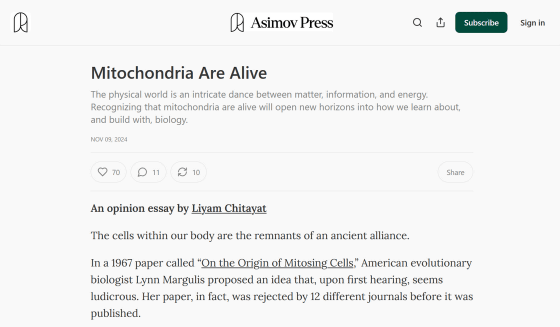Why do scientists think that mitochondria are 'life' rather than just organelles?

Mitochondria are organelles found in almost all eukaryotic cells, and they produce adenosine triphosphate (ATP) , the body's energy source. Mitochondria have their own genes separate from cells, and they divide and grow autonomously, and it is thought that they originated from symbiotic bacteria. Liam Chitayat, a doctoral student in the Computational Systems Biology Program at the Massachusetts Institute of Technology (MIT), explained the theory that ' mitochondria are not just organelles, but can be considered to be their own 'life.''
Mitochondria Are Alive - Asimov Press
https://www.asimov.press/p/mitochondria

Ina paper published in 1967, American evolutionary biologist Lynn Margulis proposed the endosymbiotic theory, stating that 'approximately 1.5 billion years ago, primitive eukaryotes absorbed oxygen-using bacteria, and a symbiotic relationship was formed in which the host provided nutrients and protection to the bacteria, and the bacteria supplied energy to the host, which eventually gave rise to modern mitochondria and chloroplasts .'
Initially, this theory was criticized as absurd, but as evidence gradually emerged that the membrane structure and molecular machinery within mitochondria are very similar to those of extant bacteria, the theory that 'mitochondria are organelles that evolved from symbiotic bacteria' has come to be widely accepted.
Chittayat goes a step further and argues that 'mitochondria are not just organelles, but living organisms in themselves.' The difference between whether mitochondria are organelles or living organisms may seem like a trivial issue at first glance. However, Chittayat says, 'Defining mitochondria as non-living is not just a classification error or a matter of word choice. Rather, it is a fundamental misunderstanding of the nature and role of mitochondria.'

Biologists have long debated the definition of life, which can be broadly divided into two categories: 'definitions that focus on characteristics such as metabolism, growth, response to stimuli, reproduction, information processing ability, and ability to evolve,' and 'thermodynamic definitions that define life as an entity that constantly exchanges matter and energy with the surrounding environment and maintains a highly organized structure.' Chitayat argues that mitochondria are clearly classified as 'life' under either of these definitions.
Mitochondria have their own genome, express their own genes using different biomolecules than the cell's nucleus, replicate and divide through binary fission just like bacteria, and their DNA mutates (evolves) through a process different from that of the host, so if we consider bacteria as living organisms, it would be unnatural not to consider mitochondria as living organisms.
From a thermodynamic point of view, mitochondria take in low-entropy substances such as glucose and fatty acids from the host cell and excrete high-entropy substances such as carbon dioxide and water. In the process, they maintain an internal thermodynamic balance, and the ATP produced as a by-product is used by organisms such as humans. This interaction with the environment is the same as that of other cells, and from a thermodynamic point of view, it is difficult to distinguish between living organisms and mitochondria.

Despite these evidences, those who do not recognize mitochondria as living organisms argue that 'mitochondria can only exist within the cells of living organisms, and do not perform metabolism or division independently.' However, most living organisms on Earth, like mitochondria, cannot survive in isolation from a specific environment.
For example, human fetuses spend many months in the womb and cannot survive outside the womb. Also,
'All living things evolve and live embedded in their environment and biological systems, and different living things are embedded at different layers,' says Chittayat. Organisms evolve to adapt to and live in certain systems, but they can also survive for a while when embedded in another system. In fact, mitochondria have been shown to move between host cells, and in the past, experiments have been successful in transplanting mitochondria from chimpanzees and gorillas into human cells.

'While gene editing technology for manipulating DNA has developed in recent years, no tools have been developed to manipulate the biological energy involved in mitochondria. By deepening our understanding of mitochondria, we may be able to advance the treatment of brain inflammation and Parkinson's disease , which are associated with mitochondrial dysfunction,' said Chitayat.
Related Posts:







